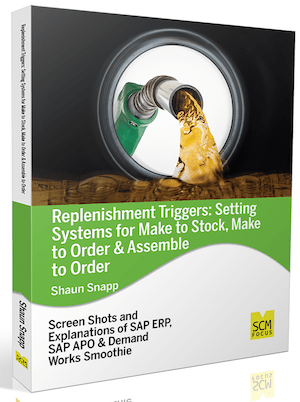
Replenishment Triggers: Setting Systems for Make to Stock, Make to Order & Assemble to Order
Screenshots and examples from SAP and Demand Works.
What The Book Covers
This is the first book to focus entirely on manufacturing environments and replenishment triggers and requirement strategies. It is, of course, not the first coverage of the topics, as requirements strategies are covered in enterprise software books while manufacturing environments are covered in business books. This book is not at all like these books. Instead, this book is simply about educating how manufacturing environments and requirements strategies work. This book is about presenting the options; it does not take a position that a company should be using this or that requirements strategy. My experience in consulting with a variety of companies is that there is a dire need for a book, which explains how manufacturing environments and specific requirements strategies, connect.
By reading this book, you will:
- Learn what the different manufacturing environments are.
- Learn all about replenishment triggers.
- Learn how planning replenishment triggers differ from execution replenishment triggers.
- Learn about requirements strategies and how they are configured in systems to match the manufacturing environment.
- Learn about forecast consumption and its relationship to requirements strategies.
Drawing upon his own vast experience as an implementation consultant and through the use of graphics and screen images from supply planning applications, Shaun Snapp empowers you to both understand and improve your systems with confidence.
Buy Now
A Book Based in Reality
The book provides many examples from real-life project experiences, the emphasis being on the reality of supply planning projects.
Interconnected to Web Information
In order the keep the book at a manageable and easily readable length, the book also provides numerous links out to the SCM Focus site, where supporting articles allow readers to get into more detail on topics that interest them.
Chapters
- Chapter 1: Introduction
- Chapter 2: The Different Manufacturing Environments
- Chapter 3: Triggering Replenishment
- Chapter 4: Requirements Strategies
- Chapter 5: The Make to Order Illusion
- Chapter 6: The Limitations to the Concept of Mass Customization
- Chapter 7: Forecast Consumption
- Chapter 8: Conclusion
Table of Contents
Chapter 1: Introduction
- The Confusing Nature of Requirements Strategies
- Books and Other Publications on Safety Stock and Service Level
- The Use of ScreenShots in the Book
- Timing Field Definitions Identification
- How Writing Bias Is Controlled at Brightwork Research & Analysis and Brightwork Research & Analysis Press
- The Approach to the Book
- Important Terminology
- The Brightwork Research & Analysis Site
- Intended Audience
- Related Books
- Abbreviations
- Corrections
Chapter 2: The Different Manufacturing Environments
- The Major Manufacturing Environments
- The Unique Manufacturing Environment of Engineered to Order
- Conclusion
Chapter 3: Triggering Replenishment
- Replenishment Triggers
- Supply Planning System Generated Triggers
- Execution Triggers
- KANBAN
- Using KANBAN Along with MRP?
- Supply Planning Versus KANBAN
- Physical or Manual Triggers
- Planned by the Truck’s Arrival or by an Incremental Stock Transport Order?
- Conclusion
Chapter 4: Requirements Strategies
- The Purpose of Forecasting in an Assemble to Order Environment
- Understanding the Requirements Strategy
- Specific Requirements Strategies
- Requirements Strategies Available within Smoothie
- Assigning Requirements Strategies with Attribute Navigation
- Requirements Strategies and the BOM
- Make to Stock
- Make to Order
- Assemble to Order
- Engineer to Order
- Multiple Production Environments
- BTO/MTO
- Conclusion
Chapter 5: The Make to Order Illusion
- The Motivations of Moving to Make to Order
- The Relationship Between Make to Order and the Product’s Margin
- The Extra Costs of Make to Order for Make to Stock Environments:
- Considering the Total Costs and Quality Implications
- Assemble to Order Example 1: Computers
- Assemble to Order Example 2: Books
- Using Make to Order Where it Fits
- Conclusion
Chapter 6: The Limitations to the Concept of Mass Customization
- Product Proliferation
- The Real Problem with Forecast Accuracy
- Imposing Costs of Operations
- Unrealistic Expectations
- Everything Old is New Again
- Conclusion
Chapter 7: Forecast Consumption
- Implications to the Question of Backward Forecast Consumption
- Alternatives to Forecast Consumption
- Conclusion
Chapter 8: Conclusion

Buy Now
Questions about the Book?
Do you have any questions about the book? If so, please leave us a comment in the message box to the right, and we will address them.